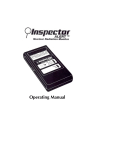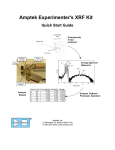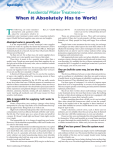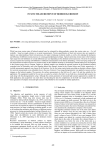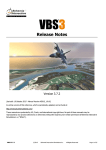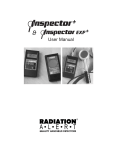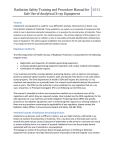Download PRM-7000, 8000, 9000 Users Guide
Transcript
PRM-7000 / 8000 / 9000 Nuclear Radiation Monitor Users Guide 2 | PRM-7000 / 8000 / 9000 Users Guide Mazur Instruments 200 South Wilcox Street #448 Castle Rock, CO 80104 USA © 2008-2014 Mazur Instruments All Rights Reserved PRM-7000 / 8000 / 9000 Users Guide Contents 1. Safety Information . . . . . . . . . . . . . . . . . 5 2. Controls, Indicators and Connections. . . . . . . . . . 6 3. Using The PRM Instrument For The First Time . . . . . . 7 3.1 3.2 3.3 3.4 Powering On the PRM Instrument . Muting The Beeper . . . . . . . Setting Desired Measurement Units Setting Time and Date . . . . . . . . . . . . . . . . . . . . . . . . . . . . . . . . . . . . . . . . . . . . . . . . . . 7 7 8 8 4. Home Screen . . . . . . . . . . . . . . . . . . . 9 4.1 4.2 4.3 4.4 4.5 4.6 4.7 4.8 Current Measurement . . . . . . . Average Measurement . . . . . . Maximum Measurement . . . . . . Minimum Measurement . . . . . . Total Count Measured . . . . . . . Time/Date of Maximum Measurement Current Time and Date . . . . . . Elapsed Time . . . . . . . . . . . . . . . . . . . . . . . . . . . . . . . . . . . . . . . . . . . . . . . . . . . . . . . . . . . . . . . . . . . . . . . . . . . . . . . . . . . . . . . . . . 9 10 11 11 11 11 11 12 5. Navigating the Menu System . . . . . . . . . . . . . 13 6. Performing a Timed Measurement (Timed Measure) . . . . 14 6.1 Perpetual Timed Measurements . . . . . . . . . . . . . 15 7. Changing the Units of Measurements (Set Units) . . . . . 15 8. Selecting User Preferences (Settings) . . . . . . . . . 15 8.1 8.2 8.3 8.4 8.5 8.6 8.7 8.8 8.9 Beeper On/Off . . . . . . . . . . . . . . . . LED On/Off . . . . . . . . . . . . . . . . . Alarm On/Off . . . . . . . . . . . . . . . . Setting Alarm Threshold in mR/hr (mR/hr Alarm) . . Setting Alarm Threshold in uSv/hr (uSv/hr Alarm) . . Setting the Time and Date (Set Time/Date). . . . . Internal Battery Power Management Setting (Bt-Pwr:) External Power Management Setting (Ex-Pwr:) . . . Low AvWin . . . . . . . . . . . . . . . . . . . . . . . . . . . . . . . . . . . . . . . . . . . . . . . . . . . . . 15 16 16 16 16 16 17 17 18 9. Utilities . . . . . . . . . . . . . . . . . . . . . 19 9.1 9.2 Resetting Counter Values (Reset Counters) . . . . . . . . 19 Performing a Hardware Reset (Hardware Reset) . . . . . . 19 | 3 4 | PRM-7000 / 8000 / 9000 Users Guide 9.3 9.4 9.5 9.6 Powering Down the Unit (Power Down) . . . . . . . . Restoring Factory Calibration (Load Defaults) . . . . . Displaying Battery and External Voltages (Display Bat/DC) Calibration Procedure (Calibrate) . . . . . . . . . . . . . . . . . . 19 19 19 20 10. Configuring the Audio/Data Connector (Ext Audio/Data) . . . . . . . . . . . . . . . . . . 21 11. Data Logging . . . . . . . . . . . . . . . . . . . 22 11.1 11.2 11.3 11.4 Setting the Interval and Starting Data Logging Checking Log Status While Logging . . . . Stopping the Log . . . . . . . . . . . . Sending (Uploading) Data to a PC or Mac . . . . . . . . . . . . . . . . . . . . . . . . . . . . . . 22 22 23 23 12. Selecting the User Interface Language (Language) . . . . 25 13. Replacing the Internal Battery . . . . . . . . . . . . 26 14. Fundamental Measurement Procedures . . . . . . . . 27 14.1 Determining Background Radiation. . . . . . . . . . . . 27 14.1.1 About Background Radiation . . . . . . . . . . . . . . . . 27 14.1.2 Measuring Background Radiation . . . . . . . . . . . . . . 28 14.2 14.3 14.4 14.5 14.6 14.7 Area Measurement and Monitoring . Measuring Objects . . . . . . . Scanning for Surface Contamination Measuring Food . . . . . . . . Measuring Liquids . . . . . . . Measuring Air . . . . . . . . . . . . . . . . . . . . . . . . . . . . . . . . . . . . . . . . . . . . . . . . . . . . . . . . . . . . . . . . . . . . . . . . . . . 29 29 30 30 31 32 15. Interpreting Measurements. . . . . . . . . . . . . . 33 15.1 Units . . . . . . . . . . . . . . . . . . . . . . . 33 15.2 What is a Safe Level of Radiation? . . . . . . . . . . . . 34 16. Additional Resources . . . . . . . . . . . . . . . . 35 16.1 Web Resources . . . . . . . . . . . . . . . . . . . 35 16.2 Additional Reading . . . . . . . . . . . . . . . . . . 35 17. PRM-7000 Specifications¹ . . . . . . . . . . . . . . 36 18. PRM-8000 Specifications¹ . . . . . . . . . . . . . . 38 19. PRM-9000 Specifications¹ . . . . . . . . . . . . . . 40 20. Warranty . . . . . . . . . . . . . . . . . . . . . 42 PRM-7000 / 8000 / 9000 Users Guide 1. Safety Information This symbol indicates important information that requires additional attention by the user. High Voltage is present in the PRM Instrument. This symbol indicates that additional caution should be exercised by the user. Notify your local environmental and/or hazardous material authorities if you have concerns that your environment consists of nuclear radiation levels that exceed the accepted limits established by the environmental or hazardous materials agencies in your locale. | 5 6 | PRM-7000 / 8000 / 9000 Users Guide 2. Controls, Indicators and Connections PRM-7000 / 8000 / 9000 A 2-Line by 14-Character Backlit LCD B Radioactive Event LED Indicator C Back Key D External Audio and Data Jack E External DC Power Input Jack F Up Key G Down Key H Sound Port I Select/Power On Key J Geiger-Müller Pancake Tube Window (PRM-9000 Only) K Geiger-Müller Tube Gamma Detection Center Point (Crosshair Printed on Bottom of PRM-7000 / 8000 Only) L Geiger-Müller Tube Alpha Detection Window (PRM-8000 Only) PRM-7000 / 8000 / 9000 Users Guide 3. Using The PRM Instrument For The First Time This section provides some basic operations most new users will want to perform before using the PRM Instrument. 3.1 Powering On the PRM Instrument Press and hold down until the start up message and serial number is displayed on the LCD. After approximately three seconds the unit will default to the home screen and begin displaying the current measurement. The unit will beep every time it detects an ionized radiation particle. This detection is normal everywhere as background radiation exists everywhere. Your particular background radiation level is dependent on many factors including altitude. For example, in Castle Rock, Colorado a normal background radiation measurement is 0.022 mR/hr while in Miami, Florida a normal background radiation measurement would be in the 0.012 mR/hr range. For comparison, on an airplane, at cruising altitude of 40,000 feet, a typical reading would be in the vicinity of 0.400 mR/hr, or approximately 180 beeps per minute for the PRM-7000, 400 beeps per minute for the PRM-8000, or 1,400 beeps per minute for the PRM-9000. Additional information on background radiation and its measurement using the PRM Instrument can be found in the Users Guide, section 14.1 “Determining Background Radiation.” For more information on radiation units see the Users Guide, section 15.1 “Units.” 3.2 Muting The Beeper The beeper is a vital indicator on the PRM Instrument. Changes in the rate of beeps will be the first indication of a radioactive object or area. However, it is oftentimes desirable to mute the beeper. To mute the beeper: 1. If the Display is off (power saving mode), press any key to wake up the PRM Instrument 2. Press to display the “Main Menu” 3. Press two times to display the “Settings” menu 4. Press to select the “Settings” menu 5. The first setting displayed is the beeper and the factory default is “Beeper: Medium” 6. Press 7. to move back to the “Main Menu” and press again to return Press to the Home Screen to rotate through the beeper settings until you reach “OFF” | 7 8 | PRM-7000 / 8000 / 9000 Users Guide 3.3 Setting Desired Measurement Units The PRM Instrument can display measurements in microrems per hour (μR/hr), millirems per hour (mR/hr), microSieverts per hour (μSv/hr), Counts per Second (CPS) or Counts per Minute (CPM). 1. If the Display is off (power saving mode), press any key to wake up the PRM Instrument 2. From the Home Screen, press 3. Press once to move to “Set Units” 4. Press key to select the Set Units menu 5. The current units will be displayed and pressing the change the setting 6. Press to activate the Main Menu key will when complete to return to the Main Menu 3.4 Setting Time and Date 1. If the Display is off (power saving mode), press any key to wake up the PRM Instrument 2. Press to display the “Main Menu” 3. Press two times to display the “Settings” menu 4. Press to select the “Settings” menu 5. Press Date” or 6. Press to select and the Time/Date setting screen will be displayed 7. Press the digit to move the cursor to the desired digit and 8. Once the desired time and date are entered, press setting to scroll through the settings. Stop at “Set Time/ to advance to save the NOTE: The Clock default Time is 00:00:00 and the default date is 01/01/11. The clock will be reset to the default time when the user initiates a Hardware Reset or when the battery has been replaced. The clock will continue to function when the user powers down the device. PRM-7000 / 8000 / 9000 Users Guide 4. Home Screen The Home Screen provides the user with the ability to quickly access measurement and keys allow the user to scroll information with a single key press. The key turns the through various displays as indicated in the table below. Pressing the LCD backlight on and off. Home Screen Operation Toggle Backlight On and Off or Move up and down through the seven screens: 1. Current Measurement (Section 4.1) 2. Average Measurement (Section 4.2) 3. Maximum Measurement (Section 4.3) 4. Minimum Measurement (Section 4.4) 5. Total Count Measured (Section 4.5) 6. Time/Date of Maximum Measurement (Section 4.6) 7. Current Time and Date (Section 4.7) 8. Elapsed Time Since Power Up, or Reset (Section 4.8) Select Main Menu This Home Screen and the recording of the measurements indicated above has been implemented in the PRM Instrument specifically to provide the user with a complete assessment of the radiation level of the environment where the monitor is located. While powered on and even in sleep mode, the PRM Instrument is constantly recording this information and doing so while preserving battery power. The following sections provide additional detail on the screens. 4.1 Current Measurement This display indicates the current radiation measurement in the chosen measurement units. The user can select microrems per hour (μR/hr), millirems per hour (mR/hr), microSieverts per hour (μSv/hr), Counts per Second (CPS) or Counts per Minute (CPM). The default unit of measurement is mR/hr. While powered on, the PRM Instrument takes measurements every second. At low levels of radiation (less than 6.00 mR/hr) these measurements are averaged across the number of seconds as determined by the Low AvWin setting. The default setting is 20 seconds. In this setting the display will update with the average of the last 20 seconds of measurements. The setting can be changed to enable a quicker (shorter averaging period) response time at low levels. | 9 10 | PRM-7000 / 8000 / 9000 Users Guide Quicker response times are useful for locating objects and/or areas which are the source of radiation levels that are above the normal background levels See Section “8.9 Low AvWin” on page 18 for more information on the Low AvWin setting. NOTE: Because of the random nature of background and low-level radiation, it is normal for the Current measurement to vary while observing the display. Also note that the maximum value viewed on the Current display is averaged over the Low AvWin setting of 5, 10 or 20 seconds. At low levels of less than 6.00 mR/hr, The Maximum screen (discussed below) is the Maximum value measured and averaged across one minute. It is normal that maximum values observed in the Current Measurement display will likely differ from those recorded in the Maximum Measurement display. 4.2 Average Measurement This display indicates the Average dose rate level that has been measured since the device was turned on, or since the Average, Maximum, Minimum, Total and Elapsed Time counters were reset. This capability is very useful for determining the normal background radiation and together with Maximum and Minimum Measurement displays (discussed below), for long term monitoring of an area or an object. The PRM Instrument is constantly counting all pulses from the Geiger tube and calculating the average by dividing the total count by the elapsed time and then compensating through the calibration solver to accurately represent the average in the selected dose rate units. NOTE: The Average, Maximum, Minimum and Total counters, as well as the Time/ Date of Maximum and Elapsed Time registers, are reset by any of the following: 1. The unit is powered on 2. A Hardware Reset is performed 3. The user resets the counters from the Utility menu 4. After the user performs a Timed Measurement PRM-7000 / 8000 / 9000 Users Guide | 11 4.3 Maximum Measurement This display indicates the Maximum dose rate level that has been measured since the device was turned on, or since the Average, Maximum, Minimum, Total and Elapsed Time counters have been reset. This capability provides valuable insight into one-time events or conditions that occur while the user is away from the device. When a new maximum is recorded, the PRM Instrument notes the time and date and stores this information for later viewing by the user. 4.4 Minimum Measurement This display indicates the Minimum dose rate level that has been measured since the device was turned on, or since the Average, Maximum, Minimum, Total and Elapsed Time counters have been reset. This provides useful information as to the minimum value the device has measured. NOTE: At low levels of less than 6.00 mR/hr, The Maximum and Minimum are averaged over one minute. At higher levels, the Maximum and Minimum are determined by measurements recorded every second. 4.5 Total Count Measured This display indicates the total number of pulses from the Geiger tube recorded by the PRM Instrument since the device was turned on, or since the Average, Maximum, Minimum, Total and Elapsed Time counters have been reset. The value is uncompensated and indicates only the number of pulses detected by the device which corresponds to the number of times the audible click sounds, or the LED blinks. 4.6 Time/Date of Maximum Measurement When a new Maximum dose rate level is recorded, the PRM Instrument captures the time and date that the Maximum occurred. This allows the instrument to capture and report transient maximums in radiation level that may occur within an otherwise normal background radiation environment. Time format on this screen is 24 hour hh:mm:ss and the date format is: MM:DD:YY. 4.7 Current Time and Date This screen displays the time and date of the real time clock/calendar within the PRM Instrument. Time format is 24-hour hh:mm:ss and the date format is: MM/DD/YY. 12 | PRM-7000 / 8000 / 9000 Users Guide 4.8 Elapsed Time This screen displays the elapsed time in days, hours, minutes and seconds since the last reset of the Elapsed Time registers. The Elapsed Time shows the time frame durin which the Average, Minimum and Maximum values have been established. PRM-7000 / 8000 / 9000 Users Guide | 13 5. Navigating the Menu System Pressing the key from the Home Screen activates the Main Menu. From the Main Menu, users can navigate through the menus as indicated in the table below. Each submenu will be discussed in the sections that follow. Select Main Menu or Move up or down through the sub-menus: 1. Timed Measure This function allows users to take measurements over a defined amount of time. This is useful for detecting small amounts of contamination. 2. Set Units Users can select either μR/hr, mR/hr, μSv/hr, CPS or CPM measurement units. 3. Settings This sub-menu allows the user to customize the behavior of the PRM Instrument. Settings include those associated with the beeper, LED, dose-rate alarm, time/date, power settings as well as the control over the averaging performed at low dose rates. 4. Utilities This sub-menu includes functions to reset the measurement counters (Average, Minimum, Maximum, Total and Elapsed Time), perform a hardware reset, power down the device, load the factory calibration values, display the voltage of the battery and perform the calibration procedure. 5. Ext Audio/Data This sub-menu is used to control the behavior of the audio/ data jack. The jack can output audio at three selectable volume levels, provide a pulse output compatible with third party software or output a serial data stream (optional cable required) on the minute for data collection using a PC. 6. Data Logging This sub-menu provides functions to control data logging to the internal logging memory in the PRM Instrument. 7. Language This allows the user to set the language to English or Japanese Select the desired sub-menu. Repeat the process for navigating through the sub-menus Return to previous menu 14 | PRM-7000 / 8000 / 9000 Users Guide 6. Performing a Timed Measurement (Timed Measure) Timed measurements provide a measurement over a fixed period of time. Timed measurements extend the sensitivity of the detector by extending the measurement over longer periods of time. This capability is useful for detecting low-level radiation above the established background count. Consider the opening of a flower blossom. From hour to hour the differences are hardly noticeable, but when still images are recorded over a long period of time and played back, the changes are clearly noticeable. Similarly, timed measurements that detect one or two additional particles every minute will result in a noticeable difference when a 90-minute timed measurement is taken. The resultant average would indicate a value noticeably above the normal background count. The PRM Instrument can take timed measurements in 1,5,10,20,30,60 or 90 minutes. To take a timed measurement, set the desired length and start the measurement as follows: to activate the Main Menu 1. From the Home Screen, press 2. Press again to select the “Timed Measure” menu 3. Press once to display the “Length: ##” setting 4. The current length will be displayed and pressing the rotate through the settings. Select the desired length 5. once to display the “Start” command and press Press the timed measurement 6. As the measurement progresses, the time remaining in minutes will be displayed along with the current average value 7. If audio is enabled, a series of tones will sound indicating that the timed measurement is complete 8. During the measurement, pressing 9. After completion, or to end the timed measurement early, press any other key. The prompt “Cancel Timed Measure?” will be displayed 10. (to answer YES) to end the timed measurement and return Press to the Home Screen key will to start will toggle the LCD backlight NOTE: Once the length is chosen in Step 4 above, it will be saved. To start future timed measurements of the same length, simply press the key three times. PRM-7000 / 8000 / 9000 Users Guide | 15 6.1 Perpetual Timed Measurements By resetting the in-line statistical counters - see “9.1 Resetting Counter Values (Reset Counters)” - the combination of the Elapsed Time Display and the Average Screens forms the basis for a perpetual, any-length, timed measurement. The true average of actual counts over the elapsed time enables timed measurements of hours, days or even months. This is very useful for long term monitoring. NOTE: After completion or cancellation of a Timed Measurement, the PRM Instrument will reset the Average, Minimum, Maximum and Total Count Registers, as well as Elapsed Time Register. 7. Changing the Units of Measurements (Set Units) The PRM Instrument can display measurements in microrems per hour (μR/hr), millirems per hour (mR/hr) and microSieverts per hour (μSv/hr), Counts per Second (CPS) and Counts per Minute (CPM). to activate the Main Menu 1. From the Home Screen, press 2. Press once to move to “Set Units” 3. Press key to select the Set Units menu 4. The current units will be displayed and pressing the change the setting 5. Press key will when complete to return to the Main Menu 8. Selecting User Preferences (Settings) Various settings can be selected to enable the user to customize the behavior of the PRM Instrument as desired. Settings remain in place until the battery is exhausted. If, at any time, the user desires to replace the current settings with the factory default settings, perform a Hardware Reset of the device from the Utilities menu. to enter the Main Menu and use the arrow To enter the Settings Menu, press the to enter the keys to advance until “Settings” is displayed in the lower line. Press Settings Menu. The specific settings will be discussed in the sections that follow. 8.1 Beeper On/Off The current state of the Beeper will be displayed. Press to change. The Beeper tone sounds when a nuclear particle is detected and provides audible feedback as to the current measurement level. 16 | PRM-7000 / 8000 / 9000 Users Guide 8.2 LED On/Off The current state of LED will be displayed. Press to change. The LED blinks when a nuclear particle is detected and provides visual feedback as to the current measurement level. NOTE: When the unit enters the sleep state and the LCD display is off, the settings of the Beeper and LED will remain in effect. While these indicators have been designed to enable prolonged battery life, both the Beeper and LED should be disabled to provide the longest battery life. 8.3 Alarm On/Off This setting is used to enable or disable the dose rate alarm. The current On/Off state of to change. An Alarm condition will occur when the Alarm will be displayed. Press Alarm is On and when the Alarm dose-rate level is exceeded. NOTE: Once an alarm condition is present, the alarm will continue to sound until the measurement is no longer greater than the threshold level. 8.4 Setting Alarm Threshold in mR/hr (mR/hr Alarm) This setting allows the user to select the desired alarm level threshold in mR/hr units. Once selected the display will indicate the current setting. The table below outlines how to use the keys to enter the desired value. 8.5 Setting Alarm Threshold in uSv/hr (uSv/hr Alarm) This setting allows the user to select the desired alarm level threshold in uSv/hr units. Once selected the display will indicate the current setting. The table below outlines how to use the keys to enter the desired value. 8.6 Setting the Time and Date (Set Time/Date) Use the keys as indicated below to set the time and date. The clock is represented in 24-hour format. See “3.4 Setting Time and Date” for step-by-step instructions. PRM-7000 / 8000 / 9000 Users Guide | 17 Setting the Alarm, Time and Date Set mRh Alarm Set uSv Alarm Set Time/Date Sets the dose rate measurement in mR/hr that will result in audible alarm Sets the dose rate measurement in uSv/hr that will result in audible alarm to select digit to set digit value save setting and exit exit without change Set time and date in 24-hour format hh:mm:ss, MM/DD/YY 8.7 Internal Battery Power Management Setting (Bt-Pwr:) This setting allows the user to specify what battery power management profile to use when operating solely from the 9-Volt battery inside the PRM Instrument. The current to change. Power Setting will be displayed. Press The power settings are outlined in the table below. The factory default for battery operation is Lowest. In this setting the LCD will be turned off after 60 seconds of inactivity. While continuing to measure nuclear radiation, the unit will enter a sleep mode in order to conserve battery power. Once any key is pressed the LCD will resume normal operation. In the Lowest setting the backlight will be turned off after 15 seconds. 8.8 External Power Management Setting (Ex-Pwr:) This setting allows the user to specify what battery power management profile to use when operating from an external power source connected to the power connector of the to change. PRM Instrument. The current Power Setting will be displayed. Press The power settings are outlined in the table below. The factory default for external power operation is High. In this setting the LCD and backlight will remain on. The unit detects when external power at the proper voltage is present and will activate the external power management setting. Similarly, the unit senses the removal of the external source and will resume the battery power setting. External power management is very useful for remote, long-term application of the PRM Instrument where the device is powered by large external batteries or alternative sources such as solar cells. 18 | PRM-7000 / 8000 / 9000 Users Guide Power Management Settings Power Setting Time of Inactivity Until: (Set in Settings) LCD Off Backlight Off Lowest 60 Seconds 15 Seconds Medium 10 Minutes 45 Seconds High Always On Always On Low Battery Condition 30 Seconds 2 Seconds NOTE: If the LCD is turned off, the PRM Instrument will continue to monitor and measure radiation including current, average, maximum, minimum and total-count values Pressing any key will “wake-up” the display and operations continue normally until the inactivity threshold of the selected Power Setting is exceeded. 8.9 Low AvWin This setting allows the user to specify the time in seconds (or window) over which lowlevel measurements are averaged in the Current Measurement displayed of the Home Screen. This capability allows the user to shorten the window so that measurement response time can be increased. Increased response time is useful for efficiently locating specific sources of radioactive activity. Once at this setting, the current averaging window will be displayed in seconds. Press to change. Choices are 5, 10 and 20 seconds. The factory default is 20 seconds. PRM-7000 / 8000 / 9000 Users Guide | 19 9. Utilities The PRM Instrument provides a number of commands in the Utilities menu that will be outlined in the sections below. 9.1 Resetting Counter Values (Reset Counters) Pressing the key while at this command will reset only the Average, Maximum, Minimum and Total counters to zero and will resume measurement. This is very useful in cases where the instrument is exposed to a new level of radiation and it is desired to know the average, maximum and minimum values of that particular source or location. 9.2 Performing a Hardware Reset (Hardware Reset) Pressing the key while at this command will reset the counter in the same way as removing all power sources from the device would. Time and Date will be reset. All settings will return to the factory default. However, if a calibration record exists in the device, that calibration will be used when the PRM Instrument is reset. To restore the factory default calibration see the Load Defaults command below. 9.3 Powering Down the Unit (Power Down) The PRM Instrument is designed to be “Always-On” and the internal battery life in sleep mode can be up to 60,000 hours (under normal background conditions and using a lithium 9-Volt battery). However, for long term storage, the user may desire to power down key while at this command will power down. While powered the unit. Pressing the down the unit will not take any measurements, however, the internal clock calendar will continue to function. 9.4 Restoring Factory Calibration (Load Defaults) Pressing the key while at this command will restore the factory default calibration and erase any calibration data present in the device. Use this command with care. 9.5 Displaying Battery and External Voltages (Display Bat/DC) Pressing the key while at this command will display a screen that shows the voltage of the internal battery and any external power source connected to the power connector. A decimal point to the left-most side of the display line indicates that the respective voltage is at an acceptable level. 20 | PRM-7000 / 8000 / 9000 Users Guide 9.6 Calibration Procedure (Calibrate) Pressing the key while at this command will initiate the calibration procedure. The Calibration Procedure Should Only Be Used By A Certified Calibration Lab. The calibration process is as follows: 1. Setup Cs137 source for 20mR/hr 2. Press the 3. The unit counts down 10 seconds, beeping at each second, then takes a 60-second measurement 4. After 60 seconds, the unit beeps and displays the raw CPM 5. Make a record of the CPM reading displayed for 20mR/hr 6. Press any key to go to the 200mR/hr (125 mR/hr for PRM-9000) measurement screen 7. Repeat steps 2 through 5 for Cs137 at 200mR/hr (125 mR/hr for PRM9000) 8. Make a record of the CPM reading displayed for 200mR/hr (125 mR/hr for PRM-9000) 9. Press any key to continue and the unit will complete calibration and restart 10. A decimal point to the right of the serial number will be displayed at key to start restart. This indicates the unit is operating from calibrated values and not the factory settings. NOTE: Calibration Should Only Be Performed By Certified Calibration Labs. Visit www.MazurInstruments.com for a list of recommended calibration labs. PRM-7000 / 8000 / 9000 Users Guide | 21 10. Configuring the Audio/Data Connector (Ext Audio/Data) The standard 3.5mm audio jack on the left side of the PRM Instrument can serve multiple purposes, including being connected to external, amplified speakers and used with portable media player headphones for discreet monitoring of radioactive activity. The jack also enables connection to a PC or Mac with USB (with an optional cable) for data logging. key to activate the Main Menu. Use the arrow From the Home Screen press the keys to move to the entry: Ext Audio/Data. The current setting for the connector will be key to move through all of the available settings for the port. A displayed. Press the description of the settings follows. Audio/Data Connector Settings Off All functions of the connector are off Data Using the optional 3.5mm to USB cable, the PRM Instrument will output a comma separated value (CSV) text string every minute. The string includes the time, date, six digit CPM value as well as the text “CPM” to indicate the units. For Example: “10:30:00”,”04/08/2011”,“000025”,”CPM” <CR> Baud rate is fixed at: 57.6K baud, 8 bits, no parity, 2 stop bits Using a terminal emulator such as Terra Term (downloadable at no cost) the output of the PRM Instrument can be captured into a log file. The result is a CSV file that can be loaded into a variety of standard software tools used for analysis including Excel, Access, MATLAB and others. Note that 1000 CPM = 1 mR/hr = 10 uSv/hr Audio:Low Connector outputs audio beeps at a low volume level for headphone use or connection to external speakers Audio: Medium Connector outputs audio beeps at a medium volume level for headphone use or connection to external speakers Audio: High Connector outputs audio beeps at high volume level for headphone use or connection to external speakers Pulse Out Connector outputs a pulse each time a radiation particle is detected. This output is compatible with monitoring software such as GeigerGraph from Mineralab Exercise caution. Excessive audio volume level through headphones can seriously damage hearing. 22 | PRM-7000 / 8000 / 9000 Users Guide 11. Data Logging 11.1 Setting the Interval and Starting Data Logging The counts per minute (CPM) measurement can be logged every minute or every hour. The default logging interval is set to one minute, and the interval can be changed as follows: to activate the Main Menu 1. From the Home Screen, press 2. Press or 3. Press to select the Data Logging sub menu 4. The logging interval will be displayed as “Every: Minute” or “Every: to change the logging interval Hour”. Press 5. once to display the “Start” command and press Press data logging 6. A prompt will be displayed to let the user know that any data currently to continue and start login logging memory will be erased. Press ging or any other key to cancel logging and return to the Home Screen. until “Data Logging” is displayed to start NOTE: Turning the PRM Instrument off or performing a reset from the Utility menu will stop logging. All logging data will be preserved, however, this data should be sent to a PC or Mac for storage because restarting the log will erase the previously stored data. 11.2 Checking Log Status While Logging Once logging is started, the data logging sub-menu will have only two commands (“Stop” and “Status”) available to the user. The status of the logging activity can be checked at any time. To check the status: to activate the Main Menu 1. From the Home Screen, press 2. Press or 3. Press to select the Data Logging sub-menu 4. until “Status” is displayed and press Press status screen until “Data Logging” is displayed to display the PRM-7000 / 8000 / 9000 Users Guide The number following “Record:” indicates the number of measurements (minutes or hours, depending on the interval set) stored in the log. As logging progresses this number will increase. The number following “Memory:” indicates the number of bytes of logging memory remaining. As logging progresses, this number will decrease. 11.3 Stopping the Log Logging must be stopped before the data can be sent to a PC or Mac. To stop the log: to activate the Main Menu 1. From the Home Screen, press 2. Press or 3. Press to select the Data Logging sub menu 4. Press until “Stop” is displayed and press 5. A prompt will be displayed to make sure the user intended to stop the to stop the log log. Press until “Data Logging” is displayed to stop logging 11.4 Sending (Uploading) Data to a PC or Mac The following steps can be used for uploading log data to a PC. More detailed instructions for the Mac will be forthcoming. 1. Insert the USB cable into your computer. The driver should install automatically and install a new COM (Serial) port on your system. 2. Windows Users: To determine the COM Port of the installed Data Cable open Device Manager on your computer, navigating there via Control Panel/System, and then Hardware/Device Manager or similar menus. The Data Cable should be installed as a “USB Serial Port” under the Ports category. Make note and write down the COM Port assignment, for example COM4. Now goto Step 5 below. 3. If your system does not install the USB driver, you can find the drivers for your operating system here: http://www.ftdichip.com/Drivers/VCP.htm | 23 24 | PRM-7000 / 8000 / 9000 Users Guide 4. Windows Users: Download the VCP driver ZIP folder for your Windows version to your Windows Desktop. Extract the zipped files to a folder on your desktop. a) Open Device Manager on your computer, navigating there via Control Panel/System, and then Hardware/Device Manager or similar menus. You should see the USB Data Cable installed under “Other Devices”, indicated as “USB Serial Port” or TTL-232R-5V-AJ. b) Double click on that device file to open it, then from the ensuing screen, click on the Update Driver button. c) Choose to “Browse your computer for the Driver Software”, and browse to the folder on your Desktop containing the extracted zipped files. Select the folder, but do not open the folder - just select the entire folder by left clicking on it once. d) Choose OK and/or Next, and the computer should install the Driver software. Go to Step 2 above. 5. Once you have your COM port, use a terminal emulator, such as Tera Term. Users can download Tera Term at no cost from: http://logmett.com 6. Be sure to have the other end of the USB adapter cable plugged into the PRM Instrument. Launch Tera Term and from the main menu select “Setup” then “Serial Port” and a) select the COM port that was installed with the driver b) select Baud Rate 57600, 8 bits, 2 stop bits, no parity, no flow control. This is the baud rate that the PRM Instrument uses At this point you should see the log data when you press “Send” from the Log menu on the PRM Instrument 7. To send data from the PRM Instrument, from the Home Screen, press to activate the Main Menu 8. Press or 9. Press to select the Data Logging sub-menu 10. until “Send” is displayed and press Press tents of the log until “Data Logging” is displayed to send the con- PRM-7000 / 8000 / 9000 Users Guide 11. The Date, Time and CPM will be sent in comma separated value (CSV) format 12. Use the terminal emulator software to capture the text. Terra Term offers a variety of flexibility so that users can save the data received to a log file. Alternately, users can simply cut the data from the terminal window and paste it into a text file using Windows Notepad to create a file on the PC. 13. The resultant data file can then be opened using Excel, Open Office or other application program to analyze and plot the data. 14. NOTE: The CPM data stored in the log can be converted into mR/hr or uSv/hr using the following PRM Instrument calibration relationship: PRM-7000: PRM-8000: PRM-9000: 450 CPM = 1 mR/hr - 10 uSv/hr 1,000 CPM = 1 mR/hr - 10 uSv/hr 3,500 CPM = 1 mR/hr - 10 uSv/hr 12. Selecting the User Interface Language (Language) From the Home Screen press the key to activate the Main Menu. Use the arrow keys to move to the entry: Language. The current language setting will be displayed. key to select English or Japanese. Pressing the key will return the Press the user to the Main Menu with text displayed in the selected language. | 25 26 | PRM-7000 / 8000 / 9000 Users Guide 13. Replacing the Internal Battery To replace the battery perform the steps listed below: 1. Disconnect any external connections to the power connector and audio/data connector of the PRM Instrument 2. Using a Phillips head screwdriver carefully remove the four screws located around the keypad while being careful not to scratch the case or keypad. High Voltage is present inside the PRM Instrument. Avoid any contact with areas underneath or past the LCD towards the front of the device 3. Remove the top part of the case and gently place it on its face being careful not to over extend the ribbon cable connecting the keypad to the main board of the PRM Instrument. 4. Disconnect the 9-Volt battery clip by moving the 9-Volt battery down in its bracket so that it covers the Mazur Instruments logo and then removing the clip from the battery. 5. From the terminal side of the battery, lift the battery out over the bracket that is securing the battery in place. 6. Wait 30 seconds for the system to completely de-energize. 7. Properly discard the used battery. 8. Orient the new battery so that it is positioned to mate with the battery clip and install the clip on the new battery, then use the side of the new battery to spread apart the bracket so that the battery is secured in place. 9. The PRM Instrument should display the startup message and serial number. 10. Be sure to fold the shield into place and gently secure the cover back into position. 11. Reinstall the four Phillips head screws to complete the procedure being careful not to over tighten the screws. PRM-7000 / 8000 / 9000 Users Guide | 27 14. Fundamental Measurement Procedures 14.1 Determining Background Radiation 14.1.1 About Background Radiation Background Radiation is radioactivity from the environment where the instrument is present. There are three sources contributing to background radiation; terrestrial, manmade and cosmic. Although background radiation is present everywhere, the concentrations and distributions are not constant. Certain materials have higher concentrations of background radiation, and varying environmental and physical conditions can result in accumulations of background radiation. Terrestrial Radioactivity The naturally occurring forms of radioactive elements incorporated into the Earth during its formation that is still present are referred to as “terrestrial radionuclides.” The most significant terrestrial radionuclides include the uranium and thorium decay series, potassium-40 and rubidium-87. Virtually all materials found in nature contain some concentration of terrestrial radionuclides. Man-Made Radioactive Materials Nuclear weapons testing and nuclear power reactors have produced large quantities of radionuclides through the fissioning of uranium and other heavy elements and the activation of various elements. Examples of man-made radionuclides that could be in the environment are Cesium 137 (137Cs), Strontium 90 (90Sr), and various isotopes of Plutonium. Prior to the 1963 Limited Test Ban Treaty, fallout from atmospheric nuclear tests distributed large quantities of man-made radionuclides around the globe. Following the 1963 treaty, most nuclear weapons tests were conducted underground, although China and France continued atmospheric testing of nuclear weapons into the late 1970s. In 1996, a Comprehensive Test Ban Treaty was negotiated with the help of the United Nations. As of this writing the Comprehensive Test Ban Treaty has not been ratified by China or the United States and was broken by Pakistan and India in 1998. However, worldwide fallout concentrations have been declining since the mid 1960s. In 1964 a Department of Defense weather satellite containing a radiation source failed to achieve orbit. The Space Nuclear Auxiliary Power (SNAP) 9-A Radioisotopic Thermoelectric Generator (RTG) burned up on re-entry and dispersed the nuclear inventory (primarily plutonium-238) into the atmosphere. Incidents involving Soviet satellites with radioisotopes or nuclear reactors occurred in 1969, 1973, 1978, and 1983. In April of 1986, there was a non-nuclear steam explosion and fire at the number four reactor at the nuclear power plant in Chernobyl in north-central Ukraine. Large quantities of radioactive material were released into the environment as a result of the catastrophe. The radionu- 28 | PRM-7000 / 8000 / 9000 Users Guide clides from these incidents have been deposited in a non-uniformly around the world. Isolated pockets with elevated concentrations of man-made radionuclides can still be found. For example, ventilation systems that were installed prior to 1963 collected fallout radionuclides. If these systems are still in use and the ducts have not been thoroughly cleaned, there is a potential for elevated background radiation. Another potential source of elevated background radiation from man-made radionuclides is wood ash. Trees filter and store some airborne pollutants, including 137Cs from fallout. When the wood is burned the 137Cs is concentrated in the wood ash. Materials or equipment associated with the ash could have elevated levels of background radiation. Cosmic Radiation Cosmic radiation consists of highly energetic particles that are believed to originate from phenomena such as solar flares and supernova explosions. The Earth’s atmosphere serves as a shield for these particles, although on rare occasions a solar flare is strong enough to produce a significant radiation dose in the lower reaches of the atmosphere. Cosmic radiation is also responsible for the production of radioactive elements called cosmogenic radionuclides. These radionuclides are produced from collisions between the highly energetic cosmic radiation with stable elements in the atmosphere. Cosmogenic radionuclides include 3H, 7Be, 14C, and 22Na. 14.1.2 Measuring Background Radiation Once the PRM Instrument is moved to a new area, a new background measurement should be established as follows: 1. Place the PRM Instrument away from items that could be radioactive, such as metals, pottery, granite counter tops, etc. Ideally, locate the instrument in the center of the area that you want to monitor and locate it table height above the floor. 2. Reset the Average Counter Values - see “9.1 Resetting Counter Values (Reset Counters)” - or power-cycle the unit off and on to reset the counters. 3. Simply allow the unit to run overnight and the next morning, look at the Average measurement and note the reading. This will be the normal background count. 4. While measuring, feel free to look at the Average value to see the value it is moving towards, but do not move the unit from the current location until the background measurement is complete. 5. Alternately, a Timed Measurement can be used. See “6. Performing a Timed Measurement (Timed Measure)”. A 10-minute timed measurement will be reasonably accurate, but an hour will be more accurate. PRM-7000 / 8000 / 9000 Users Guide | 29 14.2 Area Measurement and Monitoring The PRM Instrument is designed to be always-on monitoring the area where it is located. To assess an area, simply move through the screens (See “4. Home Screen”) of the unit and view the Average, Minimum and Maximum values. Note the Maximum value measured as well as the time and date that the Maximum was recorded. NOTE: Due to the random nature of radioactivity, it is normal to detect a maximum that is 2X to 3X the normal background radiation. Sustained increases in radiation will generally be reflected in an increased Average. The dose rate alarm can also be set to provide an alarm when the threshold set by the user is exceeded, See sections “8.3 Alarm On/Off” and “8.4 Setting Alarm Threshold in mR/hr (mR/hr Alarm)” or “8.5 Setting Alarm Threshold in uSv/hr (uSv/hr Alarm)”. If an increase in the radiation of the area is suspected, re-establish the background count taking keen interest to the resulting Average and Maximum values as compared to the previously established norms for the area. If increased radiation (indicating prior contamination) is suspected in a particular region within the area, take timed measurements of the same duration. Compare results with the normal background and previous measurements to hone in on the source or location of the highest measurement. 14.3 Measuring Objects Refer to the following guidelines when measuring an object: 1. With the sensor window or crosshair pointing towards and located close to the object, slowly scan the object with the PRM Instrument noting obvious increases in the beep or LED-blink rate. 2. Think of the sensor window or crosshair as a camera lens that is “looking” at the object. Locating the window farther from the object increases the area that the PRM Instrument can “see,” but does so at a greater distance from the potential source of radiation. NOTE: The user should locate the sensor window or crosshair at a distance from the object keeping in mind that the strength of a radiation emission decreases as the square of the distance from the source. For example, if the distance from the source is doubled, the emission will decrease by a factor of four. If the distance is tripled, the emission will decrease by a factor of nine. This is known as the inverse square law. 30 | PRM-7000 / 8000 / 9000 Users Guide 3. If a suspected object, or part of an object is detected, locate the meter in close proximity and take a timed-measurement to determine the specific measurement and the extent to which the measurement exceeds the normal background count of the area. 4. If while performing guideline 1 above, no obvious increases are noticed, this does not mean that the object is completely free of radiation. Users should take timed measurement(s) of suspected objects and compare the result with the normal background radiation. 14.4 Scanning for Surface Contamination To check for radioactive contamination of a surface, please us the following guidelines: 1. Using two coins of equal size, or other shims, orient the PRM Instrument vertical with the sensor window pointed towards the surface. 2. Use a timed measurement or simply reset the counters of the PRM Instrument and allow the device to measure overnight. NOTE: Do not allow a surface that may be contaminated to come in direct contact with the PRM Instrument. Use spacers or shims to isolate the PRM Instrument from the surface and if any contamination is found, dispose of the spacers appropriately. 14.5 Measuring Food Measuring food for radiation typically requires advanced equipment and procedures. Because many foods are largely composed of water (itself a radiation shield), thorough detection often requires a special oven for “ashing” the foods. Ashing removes the water and concentrates any radioactivity present. Measuring radiation in food is also complicated by the fact that many foods, such as dried bananas and Brazil nuts, contain naturally occurring radiation. Individuals have several options for determining whether the food that they consume contains radiation: • Make no assumption and take no action and be 100% blind to the presence of radiation in food. • Assume that the food has been scanned to the standards set forth by various government agencies and departments and is safe for consumption. • Purchase and use the same advanced equipment and related procedures that such agencies use to conduct their tests • Use a personal radiation monitor such as a PRM Instrument that may not be as sensitive, accurate and thorough as advanced methods but does provides users with some level of assurance. PRM-7000 / 8000 / 9000 Users Guide The following is the procedure that Mazur Instruments follows when scanning food for radiation. This procedure is not represented as the best, most thorough or least error prone approach. 1. Prepare a test area to place the food. Do not place the food on any stone, granite, metal or other surface that could itself be partially radioactive. Plastic or glass will likely be the best choice. 2. Establish an accurate background measurement baseline for the test area by placing the PRM Instrument in the area and reconfirming the background radiation measurement. (See “14.1.2 Measuring Background Radiation”) 3. Remove the food from any packaging and place the food in the test area. 4. Always point the sensor window or crosshair towards the food and at a distance that is as close as practical without touching the food. Use appropriate shims as required, and avoid placing the instrument in a plastic bag. 5. Perform an initial scan of the entire food item by slowly moving the detector across the item in an even and steady manner while maintaining the same sensor distance from the item. Note any obvious increases in the beep or LED-blink rate of the PRM Instrument. 6. If desired, use a timed-measurement of at least 10 minutes as a secondary way to detect radiation that may have been missed using the initial scan. Note any amount of radiation measured above that of the established background baseline of step 2 above. 14.6 Measuring Liquids When measuring liquids with the PRM Instrument, use the following guidelines: 1. Orient the PRM Instrument across a suitable drinking glass or beaker with the sensor window over the liquid. The PRM Instrument should rest in a stable manner across the edges of the glass. 2. Establish an accurate background measurement baseline for the test container by placing the PRM Instrument over the container and reconfirming the background radiation measurement. (See “14.1.2 Measuring Background Radiation”)0”) 3. Fill the sample liquid as close to the top of the container as possible exercising care not to bring the liquid in contact with the PRM Instrument. If only a small amount of the liquid is available, locate an appropriately sized container as required. | 31 32 | PRM-7000 / 8000 / 9000 Users Guide 4. Perform a timed measurement of at least 60 minutes and note any amount of radiation measured above that of the established background baseline of step 2 above. 5. A second alternative is to evaporate or boil the substance. The remaining concentrate can then be measured. 6. When measuring water and similar liquids that are available in relative abundance, such as pond or rain water, it is recommended to augment this procedure by filtering a large amount of the liquid using a coffee filter or other filter. After filtration, measure the filter using “14.3 Measuring Objects” NOTE: For those interested in testing for radioactivity of well-water, a convenient location for testing is any water filter that may be in line with the water supply. When changing filters, simply measure the filter using the procedure (See “14.3 Measuring Objects”) 14.7 Measuring Air To measure contamination in air using the PRM Instrument, it is generally necessary to measure the contents of a filter that has been in use for a reasonable amount of time to filter the air of interest. Examples include whole-house heating and cooling filters, HEPA Filters and automobile cabin filters. Particles concentrate in the filter elements and if any radioactive substances will likely be in the concentrate as well. It is a good practice to measure these filters periodically if there are any concerns about radiation. To measure the filter, follow the procedure “14.3 Measuring Objects”with the addition of the following guidelines: 1. Be careful not to allow any of the dust from the filter to enter the PRM Instrument. This could contaminate the instrument. 2. Orient the filter with the surface area of the filter in the vertical position and rest the PRM Instrument on a stack of books, or other appropriate shim that provides a stable surface for moving the PRM Instrument as close to the filter as possible, without touching the filter. NOTE: Placing a piece of thin plastic in between the filter and the PRM Instrument will block the detection of alpha particles, but this arrangement will continue to enable the detection of other types of ionizing radiation. PRM-7000 / 8000 / 9000 Users Guide | 33 15. Interpreting Measurements 15.1 Units There are four different but interrelated quantities related to the measurement of radiation. Each quantity has associated units of measurement that are represented in both the English System of Measurements as well as the International System of Units, also known as SI. The four quantities are radioactivity, exposure, absorbed dose, and dose equivalent. In the order presented, these quantities start by indicating characteristics of the radiation source and end by indicating biological impact on human beings. Radioactivity refers to the amount of ionizing radiation released by a material. Whether it emits alpha or beta particles, gamma rays, x-rays, or neutrons, a quantity of radioactive material is expressed in terms of its radioactivity (or simply its activity), which represents how many atoms in the material decay in a given time period. The units of measure for radioactivity are the curie (Ci) and in SI becquerel (Bq). Exposure describes the amount of radiation traveling through the air. The units for exposure are the roentgen (R) and in SI coulomb/kilogram (C/kg). Absorbed dose describes the amount of radiation absorbed by an object or person. That is, the amount of energy that radioactive sources deposit in materials through which they pass. The units for absorbed dose are the radiation absorbed dose (rad) and in SI the gray (Gy). Dose equivalent (or effective dose) combines the amount of radiation absorbed and the medical effects of that type of radiation on a human being. For beta and gamma radiation, the dose equivalent is the same as the absorbed dose. By contrast, the dose equivalent is larger than the absorbed dose for alpha and neutron radiation, because these types of radiation are more damaging to the human body. NOTE: The detection and measurement of neutrons requires specialized instrumentation, Geiger counters do not detect neutrons. The units for dose equivalent are the roentgen equivalent man (rem) and in SI Sievert (Sv). These biological dose equivalents are commonly measured in one thousandths of a rem and is known as a millirem (mrem) or 1 millionth of a Sievert known as microSievert (uSv). For further clarification, note that a measure given in Bq indicates the radioactivity of a substance, while a measure in mrem or uSv indicates the amount of energy that a radioactive source deposits in living tissue. 34 | PRM-7000 / 8000 / 9000 Users Guide The PRM Instrument is calibrated in units of dose equivalent rate (also known as effective dose rate), referenced to Cesium 137, in milli-Roentgen per hour (mR/hr) or microSieverts per hour (uSv/hr). Micro-Roentgen per hour (uR/hr) is also provided. For activity levels, counts per minute (CPM) and counts per second (CPS) are also made available to the user. To convert the dose rate to the accumulated dose, multiply the number of hours by the dose rate. Example 1: On the PRM Instrument the Average Screen indicates 0.025 mR/hr. The Elapsed time is 3 Days and 6 hours. What is the accumulated effective dose? 1. 3 Days and 6 hours = (24 x 3) + 6 or 78 hours 2. 78 hours X .025 mR/hr = 1.95 milli-Roentgens If a safety or other exposure limit is provided in a yearly accumulated dose of millirem, or microSieverts then divide the yearly dose by the number of hours in a year. Example 2: The paper entitled “Environmental Radiation” published by the Health Physics Society (http://hps.org/documents/environmental_radiation_fact_sheet.pdf) states: ”Each year, a resident of the United States receives an average total dose from background radiation of about 3.1 mSv.” Convert this value to an average dose rate of uSv/hr. 1. 3.1 mSv (milliSeivert) per year is the same as 3100 uSv (microSieverts) per year. 2. The number of hours in a year is 365 days X 24 Hours/day or 8,760 hours. 3. Therefore, the average hourly dose rate would be 3100 uSv / 8760 or .353 uSv/hr 4. Recall that 1 mR/hr = 10 uSv/hr. Therefore .353 uSv/hr = .035 mR/hr 15.2 What is a Safe Level of Radiation? There continues to be much debate as to the safe level of radiation exposure. Opinions range from the position that there is no safe level of radiation exposure to complete acceptance of the limits established by the global collections of governments and agencies. The matter remains largely a personal choice and Mazur Instruments offers no specific advice on what constitutes a safe level. The company will leave these discussions to the global collection of experts in the domain. A list of web links is included below as a resource for the reader. PRM-7000 / 8000 / 9000 Users Guide 16. Additional Resources 16.1 Web Resources American Nuclear Society Radiation Dose Chart http://www.new.ans.org/pi/resources/dosechart/ Canadian Nuclear Safety Commission http://www.nuclearsafety.gc.ca/ ENENews.com - Energy News http://enenews.com/ Fairewinds Energy Education http://fairewinds.com/ Health Physics Society http://www.hps.org/ National Institutes of Health http://www.nih.gov/ Nick’s World Collection of Radiation Links http://www.calytrix.biz/radlinks/ United States Environmental Protection Agency - Radiation Protection Division http://www.epa.gov/radiation/ United States Nuclear Regulatory Commission (NRC) http://www.nrc.gov/ 16.2 Additional Reading Cember, H. Introduction to Health Physics. 4th ed., McGraw-Hill Medical, 2008. “Conference of Radiation Control Program Directors, Inc.” 2011. Conference of Radiation Control Program Directors. www.crcpd.org “Health Physics Society.” 2011. Health Physics Society. www.hps.org Martin, A. and Harbison, S.A., An Introduction to Radiation Protection. 3rd ed., London: Chapman and Hall, 1987. “Radiation Protection.” 2011. U.S. Environmental Protection Agency. www.epa.gov/ radiation Shapiro, J. Radiation Protection. 4th ed., Harvard University Press, 2002. Turner, J.F. Atoms, Radiation, and Radiation Protection 3rd ed. Wiley, 2007. | 35 36 | PRM-7000 / 8000 / 9000 Users Guide 17. PRM-7000 Specifications¹ Battery Life² Standard 9V Lithium 60,000 Hours / 6.85 Years Standard 9V Alkaline 28,250 Hours / 3.22 Years Measurement Front End Detector LND 713 Geiger-Muller tube, Halogen-quenched Thin Wall Beta-Gamma Detector (Made in The USA) Radiation Detected beta, gamma and x-radiation Energy Sensitivity beta / gamma / X-rays: min 35 keV gamma sensitivity: 450 CPM/mR/hr calibrated to Cesium-137 (Cs137) Accuracy ±10% Typical, ±15% Maximum Measurement Ranges 0.001 to 500 mR/hr 0.01 to 5,000 uSv/hr 1 to 500,000 uR/hr 1 to 225,000 CPM (450 CPM/mR/hr) 0 to 3,750 CPS (7.5 CPS/mR/hr) Total Count: 0 to 4,294,967,295 (32 Bit Integer) Measurement Statistics Continuous availability of Average, Minimum and Maximum dose rate measurements in either uR/hr, mR/hr, uSv/hr, CPS or CPM Time stamp on new maximum Dose Rate Alarm Alarm can be set in mR/hr or uSv/hr to any value within the measurement range. Internal Data Logging Storage 100,000 Bytes non-volatile memory Logging Intervals Every Minute or Every Hour Maximum Capacity 91,466 Minutes or Hours (90% Normal Background, 10% Full-Scale) Minimum Capacity 32,656 Minutes or Hours (100% Full-Scale Measurement Levels) Logging Output Format Standard Comma Separated Value (CSV) with time stamp and CPM Data (1000 CPM/mR/hr) PRM-7000 / 8000 / 9000 Users Guide | 37 User Interface Languages Supported English and Japanese Display Two-Line, 14-character transflective LCD with backlight for low-light conditions Keypad Weather resistant commercial-grade membrane keypad Visual Indicator LED pulses on and off when a radiation detection event occurs. LED can be disabled. Audio Indicator Tone beeps when a radiation detection event occurs. Audio can be muted. Input/Output Audio Output / Digital Interface Standard 3.5mm jack with three selectable volume levels for output to audio systems, computer speakers or media player headphones Jack can also be provisioned by the user for pulse output or as a USB Interface for logging data by PC or transferring internal data logging memory (requires optional cable) External Power 9 VDC at a minimum current rating of 100mA Environmental / Physical Temperature Range -20° to 60° C (-4° to 140° F) Size 143 x 83 x 35 mm (5.63” x 3.25” x 1.37”) Weight 261 grams (9.2 oz.) including battery Compliance CE, Lead-Free Independently tested and found to be substantially compliant with FCC requirements for home use. Approval to display FCC logo pending. Notes: 1. All specifications are subject to change without notice. 2. Assuming that background radiation is less than 25 CPM, the device is using the low-power setting and temperature of operation is 25° C (77° F). 38 | PRM-7000 / 8000 / 9000 Users Guide 18. PRM-8000 Specifications¹ Battery Life² Standard 9V Lithium 60,000 Hours / 6.85 Years Standard 9V Alkaline 28,250 Hours / 3.22 Years Measurement Front End Detector LND 712 Geiger-Müller tube, Halogen-quenched with mica end window Radiation Detected alpha, beta, gamma and x-rays Energy Sensitivity alpha: minimum 2.5 MeV; efficiency at 3.6 MeV > 80% beta: minimum 50 keV with 35% efficiency at 150 keV 75% gamma/X rays: min 10 keV (window), min 40 keV (case) 1000 CPM/mR/hr Calibrated to Cesium-137 (Cs137) Accuracy ±10% Typical, ±15% Maximum Measurement Ranges 0.001 to 200 mR/hr 0.01 to 2000 uSv/hr 0 to 3,333 CPS (16.66 CPS/mR/hr) 0 to 200,000 CPM (1000 CPM/mR/hr) Total Count: 0 to 4,294,967,295 (32 Bit Integer) Measurement Statistics Continuous availability of Average, Minimum and Maximum dose rate measurements in either uR/hr, mR/hr, uSv/hr, CPS or CPM Time stamp on new maximum Dose Rate Alarm Alarm can be set in mR/hr or uSv/hr to any value within the measurement range. Internal Data Logging Storage 100,000 Bytes non-volatile memory Logging Intervals Every Minute or Every Hour Maximum Capacity 91,466 Minutes or Hours (90% Normal Background, 10% Full-Scale) Minimum Capacity 32,656 Minutes or Hours (100% Full-Scale Measurement Levels) Logging Output Format Standard Comma Separated Value (CSV) with time stamp and CPM Data (1000 CPM/mR/hr) PRM-7000 / 8000 / 9000 Users Guide | 39 User Interface Languages Supported English and Japanese Display Two-Line, 14-character transflective LCD with backlight for low-light conditions Keypad Weather resistant commercial-grade membrane keypad Visual Indicator LED pulses on and off when a radiation detection event occurs. LED can be disabled. Audio Indicator Tone beeps when a radiation detection event occurs. Audio can be muted. Input/Output Audio Output / Digital Interface Standard 3.5mm jack with three selectable volume levels for output to audio systems, computer speakers or media player headphones Jack can also be provisioned by the user for pulse output or as a USB Interface for logging data by PC or transferring internal data logging memory (requires optional cable) External Power 9 VDC at a minimum current rating of 100mA Environmental / Physical Temperature Range -20° to 60° C (-4° to 140° F) Size 143 x 83 x 35 mm (5.63” x 3.25” x 1.37”) Weight 201 grams (9.2 oz.) including battery Compliance CE, Lead-Free Independently tested and found to be substantially compliant with FCC requirements for home use. Approval to display FCC logo pending. Notes: 1. All specifications are subject to change without notice. 2. Assuming that background radiation is less than 25 CPM, the device is using the low-power setting and temperature of operation is 25° C (77° F). 40 | PRM-7000 / 8000 / 9000 Users Guide 19. PRM-9000 Specifications¹ Battery Life² Standard 9V Lithium 42,850 Hours / 4.89 Years Standard 9V Alkaline 20,150 Hours / 2.30 Years Measurement Front End Detector LND 7317 Pancake Geiger-Muller tube, Halogen-quenched with mica window and 45mm (1.75 inch) effective diameter Radiation Detected alpha, beta, gamma and x-rays Energy Sensitivity alpha: minimum 2.0 MeV beta: minimum 0.16 MeV with 25% efficiency at 1 MeV gamma/X rays: min 10 keV (window) gamma sensitivity: 3,500 CPM/mR/hr calibrated to Cesium-137 (Cs137) Accuracy ±10% Typical, ±15% Maximum Measurement Ranges 0.001 to 125 mR/hr 0.01 to 1,250 uSv/hr 1 to 125,000 uR/hr 1 to 437,500 CPM (3,500 CPM/mR/hr) 0 to 7,291 CPS (58.33 CPS/mR/hr) Total Count: 0 to 4,294,967,295 (32 Bit Integer) Measurement Statistics Continuous availability of Average, Minimum and Maximum dose rate measurements in either uR/hr, mR/hr, uSv/hr, CPS or CPM Time stamp on new maximum Dose Rate Alarm Alarm can be set in mR/hr or uSv/hr to any value within the measurement range. Internal Data Logging Storage 100,000 Bytes non-volatile memory Logging Intervals Every Minute or Every Hour Maximum Capacity 91,466 Minutes or Hours (90% Normal Background, 10% Full-Scale) Minimum Capacity 32,656 Minutes or Hours (100% Full-Scale Measurement Levels) Logging Output Format Standard Comma Separated Value (CSV) with time stamp and CPM Data (1000 CPM/mR/hr) PRM-7000 / 8000 / 9000 Users Guide | 41 User Interface Languages Supported English and Japanese Display Two-Line, 14-character transflective LCD with backlight for low-light conditions Keypad Weather resistant commercial-grade membrane keypad Visual Indicator LED pulses on and off when a radiation detection event occurs. LED can be disabled. Audio Indicator Tone beeps when a radiation detection event occurs. Audio can be muted. Input/Output Audio Output / Digital Interface Standard 3.5mm jack with three selectable volume levels for output to audio systems, computer speakers or media player headphones Jack can also be provisioned by the user for pulse output or as a USB Interface for logging data by PC or transferring internal data logging memory (requires optional cable) External Power 9 VDC at a minimum current rating of 100mA Environmental / Physical Temperature Range -20° to 60° C (-4° to 140° F) Size 143 x 83 x 35 mm (5.63” x 3.25” x 1.37”) Weight 368 grams (13 oz.) including battery Compliance CE, Lead-Free Independently tested and found to be substantially compliant with FCC requirements for home use. Approval to display FCC logo pending. Notes: 1. All specifications are subject to change without notice. 2. Assuming that background radiation is less than 85 CPM, the device is using the low-power setting and temperature of operation is 25° C (77° F). 42 | PRM-7000 / 8000 / 9000 Users Guide 20. Warranty LIMITED WARRANTY WARRANTOR: Mazur Instruments 200 South Wilcox Street #448 Castle Rock, Colorado, 80104, USA ELEMENTS OF WARRANTY: Mazur Instruments warrants for 120 days the Geiger-Müller tube and for one year all materials and craftsmanship in the PRM-7000, PRM-8000 and/or PRM-9000 to be free from all defects with only the limitations set forth below. WARRANTY DURATION: The warranty shall terminate and be of no further effect one year (120 days on the Geiger-Mueller tube) after the original date of purchase of the product or at the time the product is: a) Damaged or not maintained as is reasonable or necessary, b) modified, c) repaired by someone other than the warrantor for a defect or malfunction covered by this Warranty, d) contaminated with radioactive materials, or e) used in a manner or purpose for which the instrument was not intended or contrary to Mazur Instruments instructions. This warranty does not apply to any PRM-7000, PRM-8000 and/or PRM-9000 that has been subjected to corrosive elements, misuse, abuse, or neglect. STATEMENT OF REMEDY: In the event that the product does not conform to the warranty at any time while this warranty is effective, Mazur Instruments will repair the defect and return the instrument to customer without charge for parts or labor. If customer is located within the continental United States, Mazur Instruments will return the instrument with pre-paid shipping. Customers outside of the continental United States will be responsible for the shipping charges and any other related fees associated with Mazur Instruments returning the instrument to the customer after warranty service. NOTE: While the product will be remedied under this warranty without charge, this warranty does not cover or provide for the reimbursement or payment of incidental or consequential damages arising from the use of or the inability to use the PRM-7000, PRM-8000 and/or PRM-9000. The liability of the company arising out of the supplying of this instrument, or its use, whether on warranties or otherwise, shall not in any case exceed the cost of correcting defects in the instrument, and after the said one year (120 days on the Geiger-Mueller tube) period all such liability shall terminate. Any implied warranty is limited to the duration of the written warranty. PRM-7000 / 8000 / 9000 Users Guide PROCEDURE FOR OBTAINING PERFORMANCE OF WARRANTY: In the event that the product does not conform to this warranty, please Email, call or write to the address above. Mazur Instruments will not accept contaminated instruments for repair under warranty or otherwise. NOTE: Before using the PRM-7000, PRM-8000 and/or PRM-9000 for the detection, measurement and monitoring of nuclear radiation, the user must determine the suitability of the product for their intended use. The user assumes all risk and liability connected with such use. The terms of this warranty are subject to change without notice. | 43











































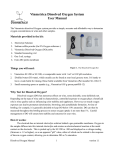
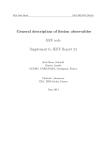
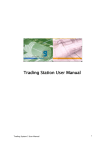
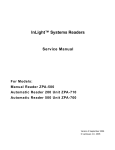
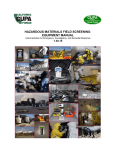
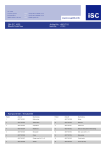
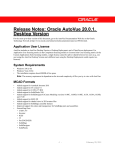
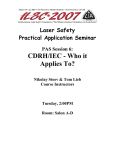
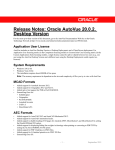
![[WAP035] [Evaluating Twittervane] Project Final Report](http://vs1.manualzilla.com/store/data/005882807_1-a2020170b6b6795bf72e9c3d683c54a5-150x150.png)
